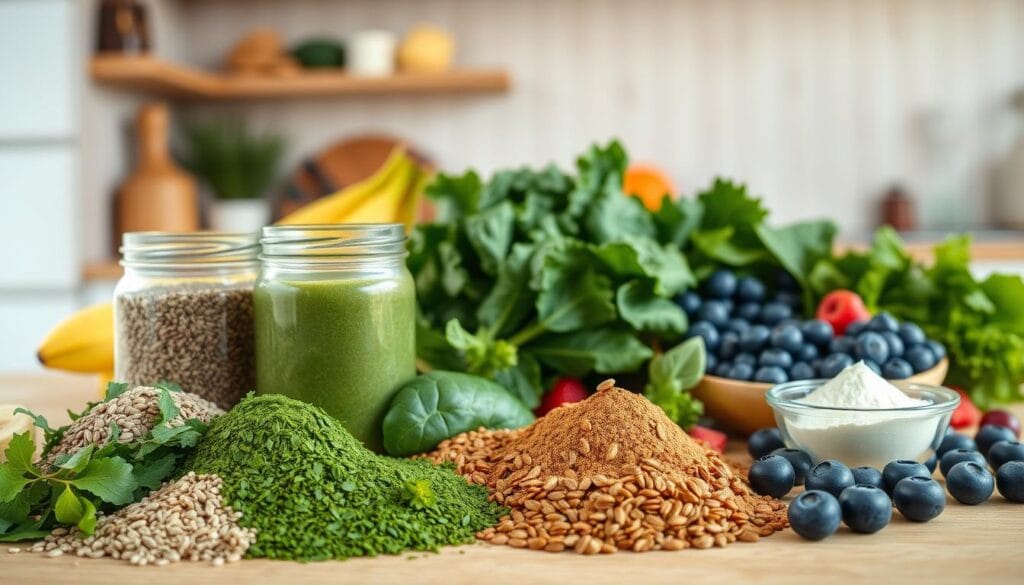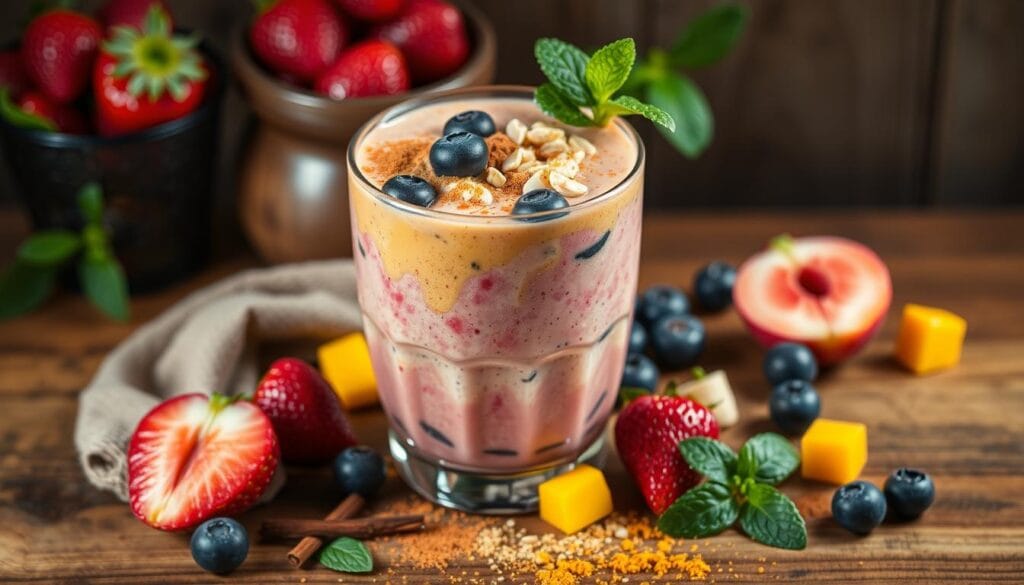Imagine starting your day with a delicious and nutritious smoothie that’s packed with your favourite fruit and made in just minutes. With just a few ingredients and a blender, you can create a quick and healthy drink that’s perfect for breakfast, snacks, or post-workout refreshment. The best part about making your own smoothie is the ability to customise it to your taste preferences and dietary needs, using the fruit you have on hand.
This article will guide you through various recipes, including a basic recipe that requires only three ingredients, and provide you with tips on how to create the perfect blend every time.
Listen to our podcast about this article
Table of Contents
Easy fruit smoothie combinations, The Perfect Smoothie Formula
Crafting the perfect smoothie is easier than you think with the right formula. A simple smoothie recipe involves combining a liquid base, fruit, and optional add-ins to create a delicious and nutritious drink.
Basic Ingredients You’ll Need
To make a great smoothie, you’ll need a few basic ingredients. Start with frozen or fresh fruit, such as a banana, and a liquid component like milk or juice. You can also add optional yoghurt for creaminess. Having at least one frozen element is crucial for achieving the perfect texture. You can also add your ingredients to a 1-cup measurement to get the right consistency.
Equipment Essentials
A good blender is essential for making smoothies. While high-end options like Vitamix are great, more affordable alternatives can still produce great results. To get the most out of your blender, prepare your ingredients by cutting fruit into smaller pieces and adding them in the right order, typically liquids first. This will ensure efficient blending and a smooth texture.
Benefits of Making Your Fruit Smoothies
Making your own fruit smoothies can be a game-changer for your health and wallet. By blending your favorite fruit combinations, you can create a delicious and nutritious drink that’s tailored to your needs.
Nutritional Advantages
Homemade smoothies offer numerous nutrition benefits, including control over ingredients, sugar content, and portion sizes. You can pack in essential vitamins, protein, and fibre to boost your daily intake of fruits and vegetables.
Cost-Effective Alternative to Store-Bought
Preparing smoothies at home is much more budget-friendly than purchasing them from a store. While store-bought smoothies can cost $5-7 each, homemade smoothies typically cost $1-2 per serving, resulting in substantial monthly and yearly savings. You can enjoy your favorite smoothie recipes without breaking the bank.
Simple Fruit Smoothie Recipes for Beginners
Starting your smoothie journey is easy with these simple and delicious recipes. You’ll find that making a great smoothie is all about combining the right fruit and ingredients.
Classic Strawberry Banana
Combine 1 cup frozen strawberries, 1 ripe banana, and 1/2 cup yoghurt for a delicious and healthy smoothie. Blend until smooth and enjoy. This classic recipe is a crowd-pleaser, and using frozen bananas adds extra creaminess.
Triple Berry Blend
Mix 1 cup frozen mixed berries, 1/2 cup milk, and 1 tablespoon honey for a sweet and antioxidant-rich treat. This recipe creates a beautiful color and is packed with nutrients.
Tropical Paradise
Combine 1 cup of frozen pineapple, 1/2 cup of frozen mango, and 1/2 cup of yoghurt for a refreshing tropical escape in a glass. This refreshing smoothie is perfect for warm days.
Creamy Smoothie Bases: Yoghurt, Milk and Alternatives
The foundation of a great smoothie lies in its base, whether you’re using yoghurt, milk, or a dairy-free alternative. The liquid base you choose affects not only the texture but also the nutritional value of your smoothie.
Greek Yoghurt Options
Greek yoghurt is an excellent choice for smoothies due to its high protein content, typically ranging from 15-20g per cup. It adds a thick, creamy texture that enhances the overall experience. You can opt for plain or vanilla Greek yoghurt with 2-5% fat to balance the tartness.
Dairy-Free Alternatives
For those who prefer or require dairy-free options, there are several alternatives available. Coconut, almond, and soy yoghurts offer unique flavor profiles and nutritional benefits. Look for soy-based yoghurt or those fortified with pea protein to boost the protein content.
Water and Juice Bases
If you prefer a lighter smoothie, you can use water or juice as your base. These options are lower in calories and can be a good choice when you want to emphasize the fruit flavors. Typically, you’ll want to use ½ to 1 cup of liquid per smoothie recipe, adjusting the amount to achieve your desired consistency.
Fruit Combinations That Always Work
To make a great-tasting smoothie, you need to start with the right fruit combinations. The right blend can elevate your smoothie game and provide a delicious treat.
Berry Medleys
Berry medleys are a classic combination that always works. Mix strawberries, blueberries, and raspberries for a deliciously sweet and tangy smoothie bursting with berry flavor. You can also add a banana to create a creamy texture.
Tropical Fruit Pairings
Transport yourself to a tropical paradise with combinations like pineapple and mango or banana, coconut, and pineapple. These bright flavors will make your smoothie taste like a vacation.
Stone Fruit Blends
Stone fruits like peaches, nectarines, and plums work well together. Try blending peaches and nectarines for a sweet and refreshing fruit blend. Experiment with different proportions (1-1.5 cups total fruits per serving) and bases like yogurt or milk to find your perfect recipe.
Adding Nutrition Boosters to Your Smoothies
Take your smoothie to new heights with these simple nutrition boosters. You can easily transform a simple fruit smoothie into a complete meal or targeted nutritional supplement by adding various nutritional boosters.
Some popular options include adding a scoop of your favorite protein powder to boost the protein content of your smoothie. For a protein boost, consider adding Greek yoghurt, cottage cheese, or silken tofu to your smoothie.
Protein Add-Ins
Boost your smoothie’s protein content with add-ins like protein powder, Greek yoghurt, cottage cheese, or silken tofu. A typical serving size is 1 scoop of powder or ¼-½ cup of yoghurt.
- Protein powder (whey or plant-based)
- Greek yogurt
- Cottage cheese
- Silken tofu
Fiber-Rich Options
Increase the fiber content of your smoothie with chia seeds, flaxseeds, oats, or psyllium husk. These additions support digestion and satiety, making your smoothie more filling and nutritious.
Healthy Fats
Add healthy fats like nut butters, avocado, coconut oil, or MCT oil to your smoothie. Use them in moderation, typically 1-2 tablespoons, to enhance the creamy texture and nutrition of your smoothie. A combination like banana, peanut butter, and protein powder is a great example.

Sneaky Veggie Additions That Taste Great
You can boost the nutritional value of your smoothies by adding vegetables without changing the flavor. This is particularly useful for picky eaters and those looking to increase their vegetable intake.
Leafy Greens
Spinach is a popular choice for smoothies due to its mild flavor and high nutritional value. It’s easy to disguise in fruit blends, especially with darker colored fruits like berries. Begin with a small portion, around ½ cup, and slowly increase the amount as desired.
Mild-Flavored Vegetables
Mild-flavored vegetables like cucumber, zucchini, and carrots can add nutrition without overpowering the fruit flavors. These veggies blend well and can enhance the overall taste and texture of your smoothie.
Veggie and Fruit Pairings
Strategic pairing of vegetables with fruits can effectively mask vegetable flavors. For example, combining spinach with banana and peanut butter or kale with pineapple and mango creates a delicious and healthy smoothie. Try out various recipes to discover your favorite flavor combinations.
Sweetening Your Smoothies Naturally
You don’t need refined sugars to make your smoothie sweet; nature provides plenty of alternatives. When crafting the perfect smoothie, achieving the right level of sweetness is crucial.
Fruit-Based Sweeteners
Fruit-based sweeteners like ripe bananas, dates, apple sauce, and mango add natural sugars and extra nutrients to your smoothie. For instance, using a ripe banana can enhance the sweetness of your recipe without adding refined sugars.
Natural Sweetener Options
For additional sweetness, consider natural sweeteners like honey, maple syrup, agave nectar, or coconut sugar. Ideally, 1-2 teaspoons of honey or maple syrup per cup is enough. Experiment with these options in your recipes to find the perfect level of sweetness.
Flavor Enhancers and Spices
The secret to making your fruit smoothies truly special lies in combining flavors with spices and extracts. By incorporating the right elements, you can elevate your smoothie game and create unique recipes.
Warming Spices
Warming spices like cinnamon, ground ginger, and nutmeg can add a cozy touch to your smoothies. Use them sparingly, typically ¼ to ½ teaspoon, to enhance the fruit flavors. For instance, cinnamon pairs well with apple, while ginger complements pineapple nicely.
Extracts and Flavor Boosters
Vanilla extract is a great addition to smoothies, providing a subtle flavor. You can also add almond extract for a rich, sweet flavor or peppermint extract for a cool, refreshing twist. Additionally, cocoa or cacao powder can be used to create rich, chocolate-based smoothies. When using extracts, start with a small amount, about ¼ teaspoon, and adjust to taste. You can add a drizzle of honey to your cup of smoothie for extra sweetness.

Smoothie Troubleshooting Tips
Even with the best recipe, things can go wrong – that’s why we’ve put together some essential smoothie troubleshooting tips. Whether you’re dealing with texture issues or flavor imbalances, we’ve got the solutions to get your smoothie back on track.
Fixing Texture Issues
If your smoothie is too thick, simply add more liquid like milk or coconut water to thin it out. On the other hand, if it’s too thin, add some ice or frozen fruit to achieve the desired consistency. For a grainy texture, blend the mixture longer or pre-soak ingredients like chia seeds before adding them to your blender.
Balancing Flavors
When your smoothie is too sweet, a squeeze of lemon juice or a dollop of plain yogurt can help balance the flavor. If it’s too tart, add a natural sweetener to taste. For a bland smoothie, try adding a pinch of salt or a flavor enhancer like vanilla. Adjusting the ingredients and adding the right amount of liquid can make all the difference.
Meal Prep: Make-Ahead Smoothie Packs
Ready-to-blend smoothie packs are the perfect solution for those looking to save time without sacrificing nutrition. By prepping your smoothie ingredients in advance, you can streamline your morning routine and ensure a healthy start.
Freezing Fruits for Smoothies
To freeze fruit for smoothies, start by rinsing and chopping fresh fruit into small pieces. Pat them dry, then arrange on a parchment-paper-lined baking sheet. Slide the baking sheet into the freezer and freeze until hard, about 2 hours. Once frozen, transfer the frozen fruit to freezer-safe bags for future use.
Creating Ready-to-Blend Bags
For meal prep, add pre-portioned smoothie ingredients (excluding liquids) to ziploc or silicon freezer bags. Store in the freezer for up to 3 months. When you’re ready, simply blend with your chosen liquid and yoghurt. This method saves time and reduces waste, making it ideal for busy mornings. You can even prep a week’s worth of smoothie packs in under 30 minutes.
Seasonal Smoothie Inspiration
The changing seasons bring an array of fruits that can elevate your smoothie game. By incorporating seasonal produce, you can create delicious and refreshing smoothie recipes that not only taste great but also provide nutritional benefits.
Spring and Summer Combinations
During the spring and summer months, take advantage of berries, stone fruits, melons, and tropical fruits like pineapple to create refreshing fruit smoothies. Try combining fruit like strawberries and bananas for a classic taste. For a more exotic flavor, blend together pineapple, orange, and a splash of juice for a tropical treat.
Some exciting recipes to try include a banana strawberry smoothie made with ½ medium banana, ½ cup strawberries, ½ cup yogurt, ½ cup milk, and 1 teaspoon vanilla extract.
Fall and Winter Blends
As fall and winter arrive, incorporate seasonal produce like apples, pears, cranberries, and citrus fruits into your smoothies. Adding warming spices can enhance the flavor and comfort of your smoothies during the colder months. Consider a recipe that includes apples, cinnamon, and a hint of nutmeg for a cozy treat.
To adapt your smoothie textures seasonally, opt for lighter, more refreshing blends in the summer and heartier, more substantial ones in the winter. Incorporating seasonal herbs like basil or mint in summer and rosemary or cinnamon in winter can add unique flavors to your smoothies.
Conclusion: Your Smoothie Adventure Begins
Your smoothie adventure is just beginning, and the versatility of fruit combinations is your playground. With the simple smoothie formula and various recipes provided, you’re ready to start experimenting.
Remember, making smoothies at home not only saves you time and money but also allows you to control the ingredients and nutritional value. Don’t be afraid to try new recipes and add your favorite fruits or tips to create the perfect blend.
Using a blender to make your favorite smoothie is a simple step toward healthier eating habits. So, get blending and enjoy the journey!








